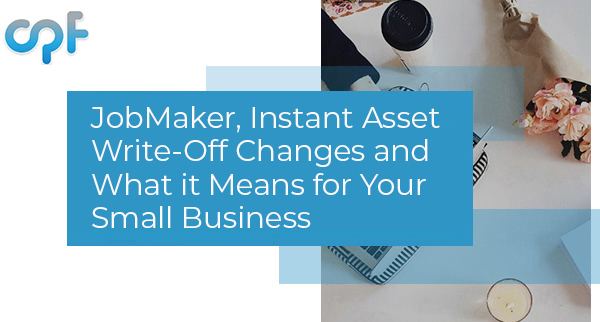As the Australian economy continues to rebound from the impacts of COVID-19, there are a range of changes to the support measures available to businesses. It’s essential your business stays up to date with the latest facts and entitlements so that you can maximise your advantage over the next few years. As part of the recent Budget announced by the Government, there are two significant changes that have now been signed into law.
The JobMaker program, alongside the existing instant asset write-off incentive both include substantial tax-based provisions for small businesses to encourage increased investment in equipment, commercial assets and employment. The Government has identified business investment and sustainable employment as key to the economic recovery plan for Australia. Small businesses deserve a fair go, and this is a great opportunity to rebound stronger from the impacts of COVID-19. Let’s take a look at what these changes mean for your business.
JobMaker
As JobKeeper is phased out over the coming months, JobMaker instead incentivises employers to hire young workers (between 16 and 35). Employers who create a new position and fill it with an eligible employee will be able to claim a hiring credit for up to $200 a week. This measure is already available and will be until October 2021. For a worker to be eligible, they must have received JobSeeker or similar support payments in the three months prior to their hiring. They’ll also need to work at least 20 hours a week for your business.
This program is expected to support over 450,000 new jobs over the next year and is an excellent opportunity for your business. Hiring new workers can be expensive and time-consuming. As your business bounces back, particularly over the upcoming busy holiday season, taking advantage of these hiring credits may go a long way to help get your business going, and the kids back to work for their futures.
Changes to the instant asset write-off incentive
As part of the JobMaker Plan, there is a provision for immediately expensing assets to encourage investment and job creation. Hand-in-hand with the previously instated instant asset write-off incentive, the new measures are termed the ‘temporary full expensing of depreciation assets.’ Under these measures:
- Businesses with turnover less than $5 billion can deduct the entire cost (previously limited to $150k) of any new eligible depreciating assets that are purchased and used or installed for use for business purposes until the 30th of June 2022 (not so temporary!)
- Small businesses with turnover less than $50 million will also be able to apply full expensing to eligible second-hand assets.
“More small businesses will be eligible for a range of tax concessions, including the expanded instant asset write-off incentive.”
Loss carry-back provisions also allow companies to offset losses against previous profits on which tax has already been paid, producing a refund in this financial year. As part of the changes, the definition of a small business has increased – from $10 million to $50 million. This means that more small to medium enterprises (SME’s) will be eligible for a range of tax concessions, including the expanded instant asset write-off incentive.
What the instant asset write-off means for your business
When your business purchases an asset for business use, the value is included as a deduction on your tax return. Businesses can claim a full deduction in the same income year as the purchase of the asset, saving potentially a large amount of tax.
One of the most common applications of this incentive is towards motor vehicles, such as cars and trucks. It’s important to note that cars are subject to a maximum write-off limit of $59,136. Cars in this context are defined as any motor vehicle that is designed to carry a load of less than one tonne and fewer than nine passengers. Commercial utes and trucks are not subject to this limit – it’s open season for the construction industry.
Exclusions and an example
While most business assets are eligible for the expanded temporary full expensing of depreciation assets, there are some important exclusions, including:
- Buildings and other capital works
- Horticultural plants
- Intangible assets
Let’s take an example to demonstrate how the incentive works for small businesses.
Small cycle hire business, On Ya Bike, has a turnover of $1.5 million and a taxable income of $300k. They pay the company tax rate of 27.5%, meaning their tax payable is $82,500.
Throughout the financial year On Ya Bike purchased two vehicles worth $80,000 ($40,000 each) – a ute to transport bikes and a car used by the managers for evenly split personal and business uses. Under the incentive, they can deduct $60,000 ($40,000 ute + half of the $40,000 car) from their taxable income.
After applying the deduction, On Ya Bike’s total tax payable is now only $66,000. So if we apply this saving to the cost of the assets, their real cost was only $63,500 ($80,000-$16,500 saving). Got that? Taxes can be confusing so make sure to consult your accountant.
Whether your small business is looking to buy a new car, machine or just needs to sure-up some cash flow, Capital Plus Finance is an experienced business finance broker that has your best interests at heart. The team at Capital Plus Finance will do everything we can to help you secure a suitable finance solution for your small business. Please give us a call anytime to find out more or to have an obligation-free chat about your business’s funding situation.





